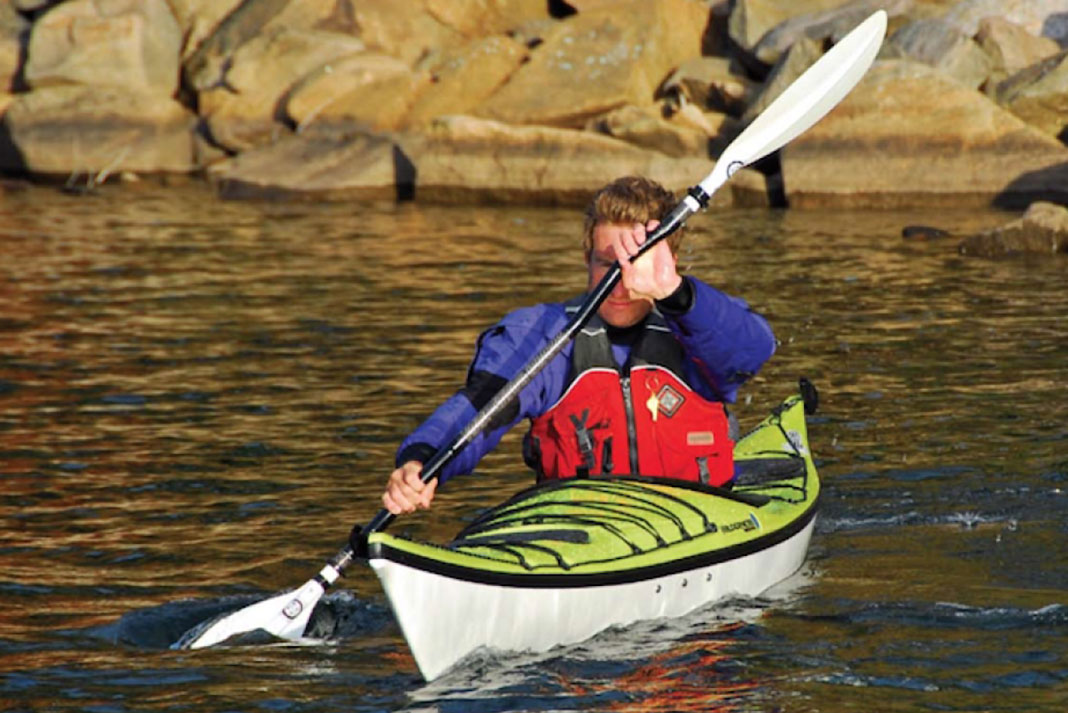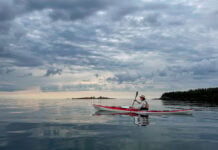Derived from the name of the Latin and Greek gods of the west wind, in English “zephyr” means “a gentle breeze from the west.” The Zephyr 160 Pro from Wilderness Systems adopts the name to suggest that this kayak, while sizeable, provides a light and airy ride for medium- to large-sized paddlers.
Wilderness Systems Zephyr 160 Pro Specs
Length: 16’
Width: 23”
Depth: 17”
Weight: 54 lbs
Capacity: 300 lbs
MSRP: $3,150 USD / $3,700 CAD
The Zephyr 160 is indeed light, being composite, and is airy in substance—like its namesake it can be everywhere at once and refuses to be nailed down on the spectrum of kayak performance. No kayak can do everything, but the Zephyr comes close to a quiver-of-one.
The Zephyr 160 is a big‑time performer
Its 16-foot length puts the Zephyr smack between day-touring and expedition classes, offering a mix of nimbleness for tootling about and storage capacity for ambitious trips. Similarly, the 23-inch width makes it neither torpedo nor tanker, swinging the needle just slightly to the side of playfulness by presenting a more rockered profile on edge. This tubby belly with a taste for rock-garden mischief spins like a dervish on a steep edge and makes room for paddler and gear.
Plenty of room to spare
The Zephyr’s cockpit is cavernous and welcomes rec kayakers making the transition to a high-performance boat. A six-foot-two paddler had the foot pegs four to five notches back from max and could barely toe the bulkhead. But there’s no sacrificing a snug fit, even for medium-sized seamen, thanks to the adjustable outfitting.
Smaller testers found the 17-inch deck a bit high, however, confirming that this is a performance punt for paddlers on the large side. We noticed that the cockpit opening seemed poorly positioned relative to the seat, or vice versa, with several inches of space behind the seat back making it harder to get a sprayskirt on.
On the go, the hull tracks straight on an even keel and holds its own, speed-wise, amidst a fleet of expedition boats. On a tilt, there’s a direct relationship between degree of edging and willingness to turn. The point-of-no-return is a point of mega-turns, providing you have a handy brace. Initial stability is more solid than its sister ship the Tempest, while secondary on this softer chine is less defined: the Zephyr 160 is friendlier to beginners, but its edging less precise.
Ride like the wind
Years ago, Wilderness Systems’ adjustable outfitting migrated over from its whitewater designs to sea kayaks and has been improving ever since, providing lickety-split customization of thigh brace position, hip pad width, and leg support height. We like.
Shallow-V hull and soft chine make for good initial stability and soft secondary—increasing degrees of edge give greater turning speed with no obvious point of resistance. When deployed, the plastic skeg felt loose and could be heard wiggling when rocking from edge to edge. Oddly, the Zephyr is available in Kevlar for the same price as fiberglass.
Attractive deck layout with generous bungee tie-downs and three waterproof rubber Kajak Sport hatches. The 10-inch bow hatch is less convenient to pack than an oval hatch, but provides greater security in rough seas. A compass mount is recessed ahead of the front hatch.
Ride like the wind with the Zephyr 160 Pro
On the Greek theme, the Zephyr 160 sticks to Aristotle’s golden mean in both capacity and performance. Also available in rugged plastic and a sportier 15.5 length suited to smaller paddlers, the Zephyr succeeds as the do-it-all high-performance kayak that Wilderness Systems claims it to be.
This article was first published in the Spring 2009 issue of Adventure Kayak Magazine. Subscribe to Paddling Magazine’s print and digital editions, or browse the archives.









